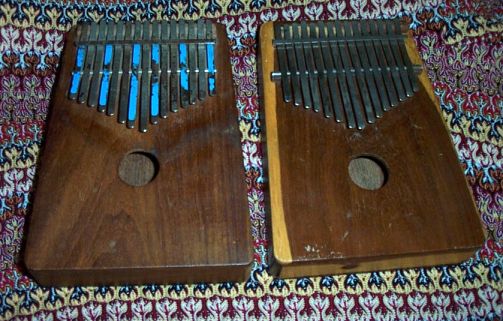HOW TO PLAY THE HUGH TRACEY KALIMBA
|
© 2003 by Richard Hayes Phillips
I first purchased a Hugh Tracey kalimba in 1979 after seeing it played by a
young lad in Cambridge, Massachusetts. When he showed me that it can be
tuned to any scale of the musicianís choosing, I understood for the first
time that it is more than a piece of folk art. It is a full-fledged concert
instrument, limited only by its two-octave range and its lack of chromatics.
Hugh Tracey was a musical pioneer who traveled the African countryside
collecting the music and studying the instruments of the natives. He became
fascinated by the mbira, traditionally made out of gourds. He designed the
kalimba with a full diatonic (seven-note) scale. It is made out of African
hardwood and steel prongs that can be moved up and down to change the pitch.
The Hugh Tracey company makes three models of kalimbas. I play only the alto
kalimba, show in the picture below, because its thicker steel prongs provide
a deeper, richer tone and will stay in tune throughout a concert performance.
All models can be purchased online at http://paultracey.org/instruments.htm.
The alto kalimba has fifteen prongs. The distance between the end of the
prong and the metal bridge running beneath and perpendicular to the prongs
determines the pitch. The longer the distance, the lower the pitch. The
bridge itself is adjustable, and I highly recommend pushing it upward with
the handle of a knife so as to lower the pitch and deepen the resonance of
each and every prong. The longest prong, and therefore the lowest note, is
always in the middle. The others are tuned in an alternating left-right
manner. Thus the instrument, designed to be played with two thumbs, is
symmetrical, unlike other keyboards with the lowest note on the far left.
The kalimba cannot be tuned to anything more than a diatonic (seven-note)
scale. There is not enough leeway on the nut (the wooden strip running
parallel to the bridge) to allow it, and any attempt to use chromatics will
 1
1
|
|
 1
1